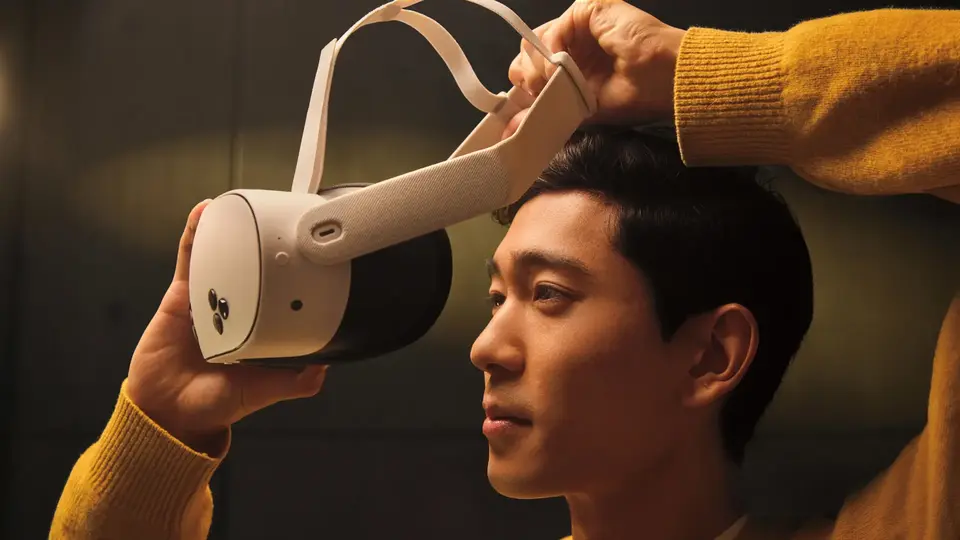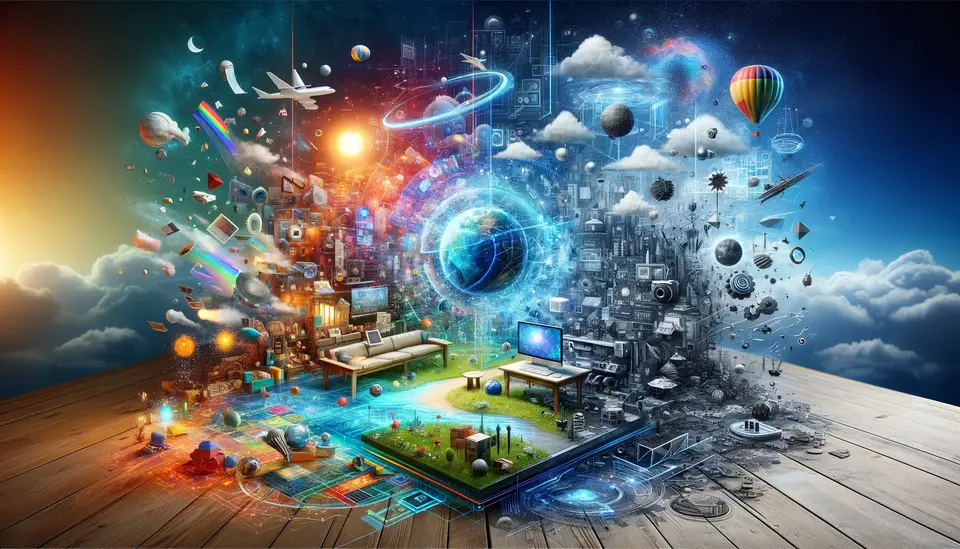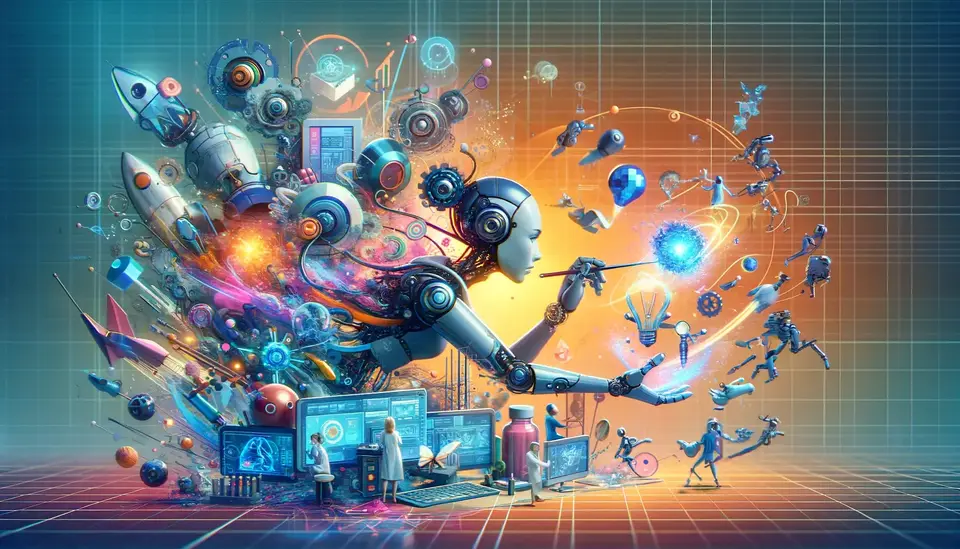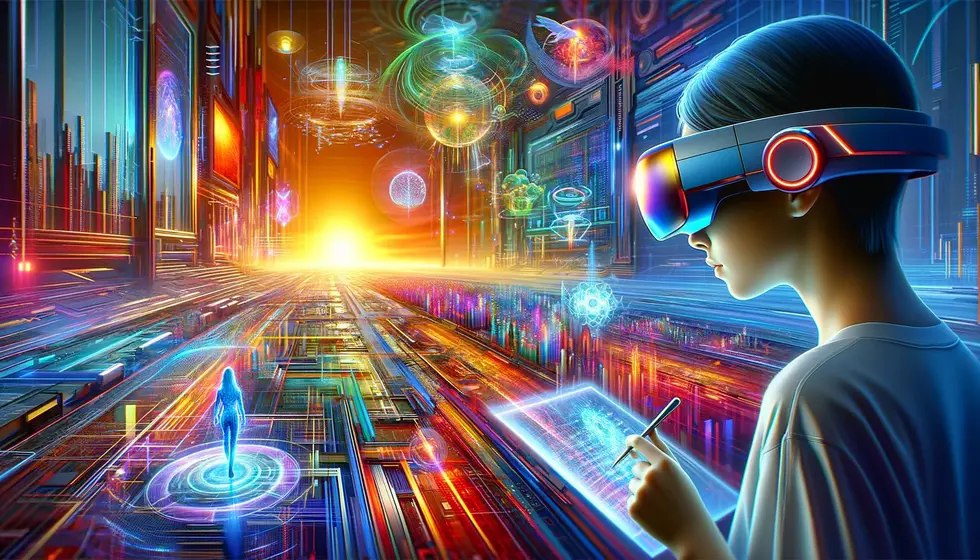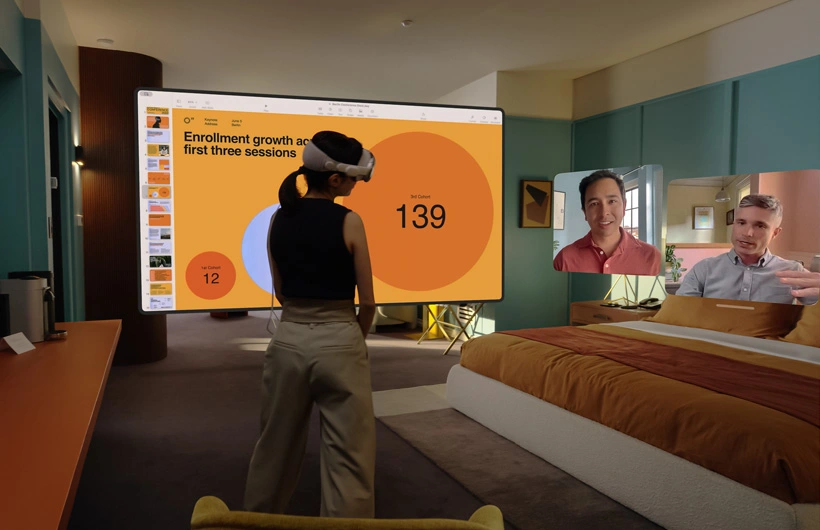Microsoft HoloLens 2: A Comprehensive Review
Posted on June 13, 2023 21 minutes 4327 words
Table of contents
- I. Welcome to the World of Mixed Reality: Unveiling the HoloLens 2
- II. Meet the Future: An Introduction to HoloLens 2
- III. The Technology Behind HoloLens 2
-
IV. The User Experience
- Ready, Set, Go: The Setup and Calibration Process of HoloLens 2
-
Stepping Into the Future: User Interface and Navigation in HoloLens 2
- User Interface and Navigation in the Age of Mixed Reality
- Main Interface: A New Home
- Eye-Tracking: Gaze Into the Future
- Gesture Control: The Power of Touch
- Hand Menu: Quick and Convenient
- Interacting with Mixed Reality: A Touch of the Future
- Voice Commands: Speak to the Future
- Holographic Elements: A New Reality
- Field of View: See More, Do More
- Calibration: A Perfect Fit
- In Conclusion
- Comfort Meets Futurism: The Wearability of HoloLens 2
- Software that Powers the Magic: A Look at Windows Mixed Reality and Apps
- Key Applications of HoloLens 2
- The Competition: HoloLens 2 vs. the World
- VII. Potential Future Developments
- VIII. Conclusion
I. Welcome to the World of Mixed Reality: Unveiling the HoloLens 2
Diving into the World of Mixed Reality: What to Expect in this Post
In the digital era, technology continues to push boundaries and redefine our understanding of reality. As we further traverse into this journey of technological innovation, we encounter fascinating concepts, one of which is “mixed reality,” brought to life by devices such as Microsoft’s HoloLens 2. This blog post will delve into the revolutionary world of the HoloLens 2, exploring its design, core technologies, user experiences, applications, competitors, and future prospects. Whether you are a tech enthusiast, a business leader looking for innovative solutions, or simply curious about the latest technological advancements, this post aims to provide a comprehensive understanding of the HoloLens 2.
The Magic Blend: What Mixed Reality Means and Why It Matters
Mixed Reality (MR), sometimes referred to as hybrid reality, merges real and virtual worlds to create new environments where physical and digital objects co-exist and interact in real-time. It’s more immersive than Augmented Reality (AR), which overlays digital content onto the real world, and more interactive and reality-based than Virtual Reality (VR), which fully immerses users into a simulated environment.
The importance of MR lies in its potential to significantly transform various industries, from healthcare and education to manufacturing and entertainment. By bridging the gap between physical and digital realities, MR allows for more engaging, immersive, and practical applications, which can lead to improved productivity, enhanced learning experiences, and the development of new forms of entertainment.
Say Hello to Microsoft HoloLens 2: A New Reality
The Microsoft HoloLens 2 is a pioneering piece of technology that epitomizes the potential of mixed reality. It’s a standalone, smart-glasses-style headset that overlays high-definition holograms onto your real-world environment. Released in 2019 as a successor to the original HoloLens, it comes with improved ergonomics, greater immersion, and more advanced hardware, offering a higher-quality and more comfortable MR experience.
Over the course of this blog post, we will delve deeper into the HoloLens 2, exploring its design, the advanced technologies that power it, the user experience it offers, its multitude of applications, and its position in the competitive landscape of AR, VR, and MR devices. Whether you’re considering incorporating the HoloLens 2 into your business, fascinated by the potential of mixed reality, or simply want to learn more about this cutting-edge technology, this blog post aims to offer a comprehensive and accessible look into the world of Microsoft’s HoloLens 2.
II. Meet the Future: An Introduction to HoloLens 2
A Journey Through Time: The Evolution of HoloLens
The journey of the HoloLens began in 2015, when Microsoft unveiled the first generation of the device. It was a groundbreaking release, marking one of the tech giant’s major forays into the emerging field of mixed reality. However, being a first-of-its-kind device, the original HoloLens had its fair share of limitations such as a relatively narrow field of view, less-than-ideal battery life, and a hefty price tag, making it primarily a tool for developers and businesses rather than for everyday consumers.
In response to the feedback and lessons learned from the initial iteration, Microsoft released HoloLens 2 in 2019. Designed with the enterprise market in mind, HoloLens 2 was a significant upgrade over its predecessor. Microsoft made improvements in several critical areas including comfort, immersive experience, and out-of-the-box utility, aiming to make the device more practical and appealing to a broader audience.
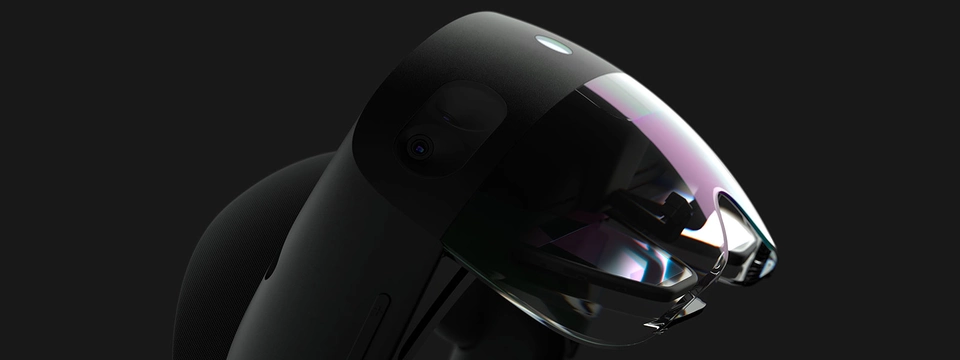
A Close Look: Unpacking the Design and Physical Features of HoloLens 2
The HoloLens 2 showcases a thoughtful design centered around user comfort and functionality. The device itself is a pair of glasses attached to an adjustable band that fits around the user’s head. It weighs about 566 grams (1.25 lbs), making it slightly lighter than the original HoloLens. The balance of the headset has also been improved, with the center of gravity shifted to the rear to reduce pressure on the nose and forehead, thus enhancing wearability during extended use.
The device features a visor that can flip up, allowing users to switch between the real world and mixed reality effortlessly. Moreover, it has built-in speakers for spatial audio, allowing for a more immersive experience without blocking out real-world sounds, and a microphone array for voice commands.

Under the Hood: The Key Specifications and Hardware of HoloLens 2
The HoloLens 2 boasts several key specifications that power its impressive capabilities:
Optics
The device has a see-through holographic lens with a 2K 3:2 light engine that provides a field of view of 52 degrees, effectively more than double the size of the original HoloLens. This increased field of view greatly enhances the user’s immersion in the mixed reality environment.
Sensors
HoloLens 2 comes with a range of sensors, including a depth sensor, an accelerometer, a gyroscope, and a magnetometer. These sensors enable spatial recognition, motion tracking, and environment understanding.
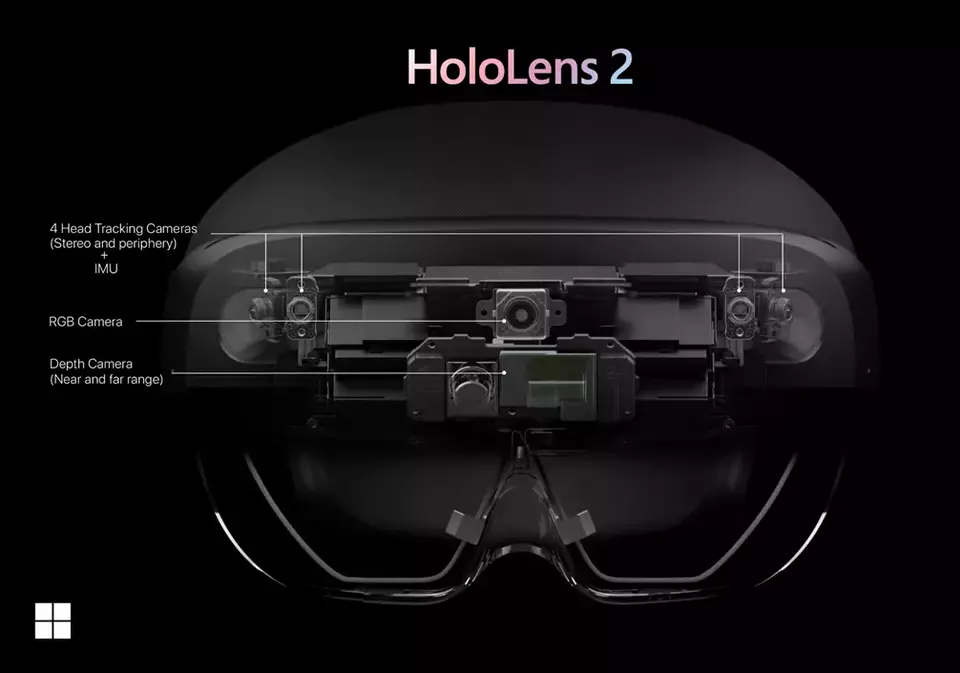
Compute and Connectivity
At the heart of the HoloLens 2 is the Qualcomm Snapdragon 850 Compute Platform, coupled with a custom-built Holographic Processing Unit (HPU). It also has Wi-Fi and Bluetooth 5.0 connectivity for communication and data transfer.
Software
The device runs on the Windows Holographic operating system, a version of Windows 10 designed specifically for mixed reality. It supports various apps and solutions, such as Dynamics 365 Remote Assist and Guides, as well as third-party applications.
Battery and Power
The HoloLens 2 comes with a USB Type-C High-Speed connector, offering fast charging capabilities. It has a battery life of about 2-3 hours under active use, suitable for most industrial use cases.
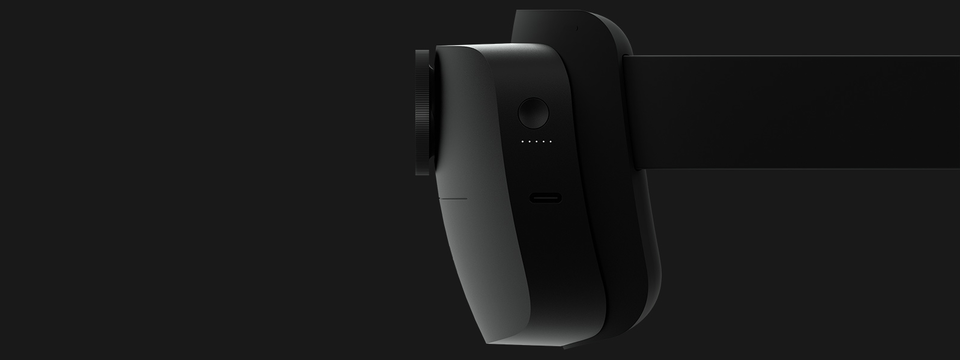
By pushing the boundaries of its design and technical specifications, HoloLens 2 offers a more immersive and comfortable mixed reality experience than ever before. The next sections will further delve into the technology powering this device and the user experience it offers.
Pricing
The Microsoft HoloLens 2 is a premium mixed reality device, and its pricing reflects its advanced capabilities and targeted use cases. There are several offerings available, each tailored to different needs:
HoloLens 2 Standard Edition
The basic model of HoloLens 2, designed for hands-free work. It comes with the device, a carrying case, a strap, a charger, and a one-year warranty. The price is $3,500.
HoloLens 2 Industrial Edition
This version is designed for use in regulated environments like clean rooms. It has additional certifications and a rapid replacement program. The price is $4,950.
Trimble XR10 with HoloLens 2
This version is integrated into a hardhat for use in tough work environments. It has noise-cancelling audio output. The price is $5,199.
HoloLens 2 Development Edition
This version is for developers to build mixed reality applications. It includes Azure credits and trial subscriptions to Unity Pro and Pixyz Plug-in. The price is $3,500, or it can be financed for $99.22/month for 36 months.
Please note that prices may vary, and it’s always best to check the official Microsoft HoloLens website for the most accurate and up-to-date information.
III. The Technology Behind HoloLens 2
Core Technologies – Spatial Mapping, Gaze Tracking, Gesture and Voice Recognition
Spatial Mapping
One of the key technologies underpinning HoloLens 2 is spatial mapping, which allows the device to understand and interpret the physical space around the user. Using its depth sensor, the device generates a 3D model of the user’s environment. This model enables holograms to interact with real-world objects, giving users a convincingly immersive mixed reality experience.
Gaze Tracking
HoloLens 2 also includes eye-tracking sensors that follow the user’s gaze, determining precisely where they are looking. This gaze tracking is critical for navigation and selection within the MR environment. It also allows for more immersive and interactive experiences, such as characters in a game making eye contact with the user.
Voice Recognition
Voice recognition technology in HoloLens 2 enables users to command and control holograms verbally. It’s supported by Microsoft’s AI assistant, Cortana, enabling a variety of voice-activated commands and queries to provide a hands-free mode of interaction.
Gesture Recognition
The device incorporates advanced gesture recognition, letting users interact with holograms using intuitive hand and finger movements. This interaction model, known as ‘instinctual interaction’, includes actions such as pinch-to-zoom and the ability to ‘grab’ virtual objects.
Understanding the Holographic Processing Unit (HPU)
A standout feature of the HoloLens 2 is the custom-made Holographic Processing Unit (HPU). This chip handles all the sensor data, processes it in real-time, and constructs and adjusts the holograms accordingly. The HPU allows the HoloLens 2 to handle vast amounts of data per second, enabling it to understand gestures, gaze, and the spatial map, all while maintaining a smooth, lag-free experience for the user. HoloLens 2 HPU specifications include the following:
- SoC: Qualcomm Snapdragon 850 Compute Platform
- Memory: 4-GB LPDDR4x system DRAM
- Storage: 64-GB UFS 2.1
- Wi-Fi: 802.11ac 2x2
- HPU: Second-generation custom-built holographic processing unit
The HPU in HoloLens 2 is also designed with an AI coprocessor to natively and flexibly implement Deep Neural Networks. This means that HoloLens 2 can analyze visual data locally without needing to send it to the cloud, resulting in lower latency and better performance.
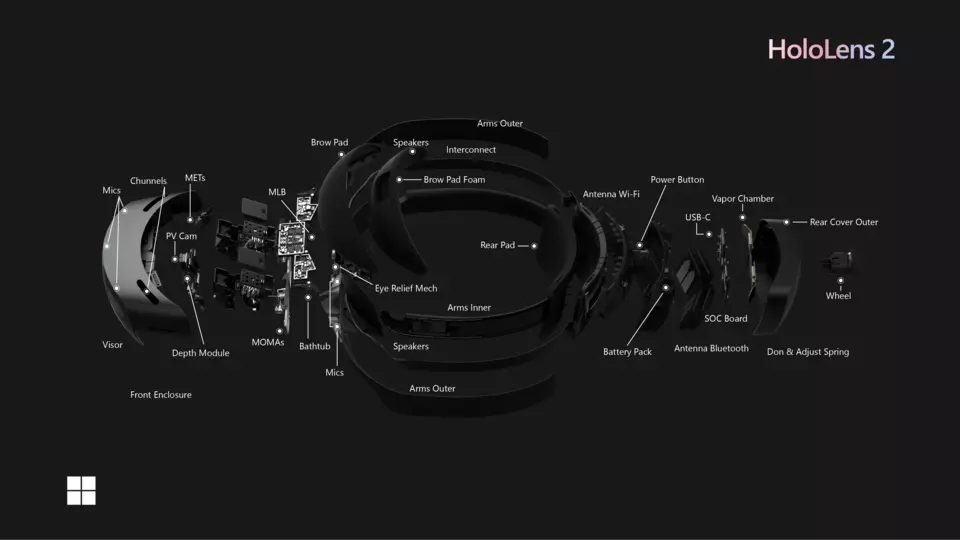
How does Mixed Reality work in HoloLens 2?
The mixed reality experience in HoloLens 2 is powered by the combined efforts of its hardware components and core technologies.
When a user puts on the HoloLens 2, the array of sensors starts mapping the environment, creating a 3D model of the surrounding space. As the user navigates this space, the sensors continually update the spatial map.
Meanwhile, the eye-tracking sensors determine where the user is looking, and the device uses this information to place and highlight holograms accordingly. The user can then interact with these holograms using gestures, their gaze, or voice commands.
The HPU processes all this information in real-time, adjusting the holograms based on the user’s interactions and movements, and the changes in the physical environment. This continuous processing and adjustment create an immersive, interactive, and convincing mixed reality experience where digital content seems to exist in the user’s physical world.
IV. The User Experience
Ready, Set, Go: The Setup and Calibration Process of HoloLens 2
Setting up the HoloLens 2 is a straightforward process, designed to be user-friendly and efficient. After powering on the device, users are guided through a series of steps including connecting to a Wi-Fi network, signing in with a Microsoft account, and setting up a device PIN for added security.
One of the critical aspects of the setup process is the calibration for eye-tracking and hand-tracking. For eye-tracking, the system asks the user to follow a visual point, ensuring accurate gaze detection. Hand-tracking calibration involves understanding the user’s hand size and how they make gestures, facilitating intuitive interaction with virtual objects.
For more details about this process, you can refer to the Microsoft guide titled “Set up your HoloLens 2”. This comprehensive resource provides additional insights and instructions on each step of the setup and calibration process. It’s an excellent tool to ensure that your HoloLens 2 experience is tailored to your individual preferences and provides optimal interaction with the virtual world.
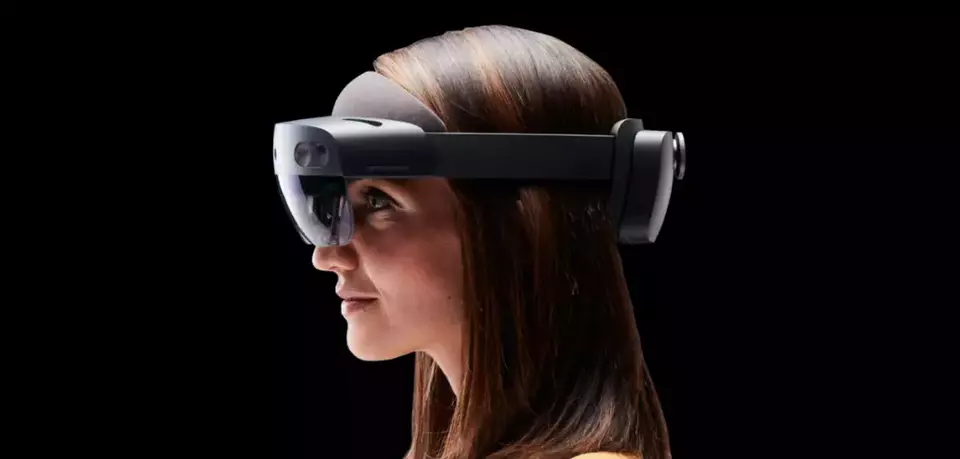
Stepping Into the Future: User Interface and Navigation in HoloLens 2
User Interface and Navigation in the Age of Mixed Reality
The user interface and navigation offered by Microsoft’s HoloLens 2 provide a unique user experience through a combination of hand gestures, voice commands, and holographic elements.
Main Interface: A New Home
The main interface, often referred to as the “home” area, presents installed apps as holographic tiles, immersing users in a futuristic experience. The process of navigating and interacting is exceptionally intuitive, with the HoloLens 2 leveraging gaze, gestures, and voice commands.
Eye-Tracking: Gaze Into the Future
The HoloLens 2’s interface includes an innovative eye-tracking feature, which enhances navigation by allowing the device to understand precisely where the user is focusing.
Gesture Control: The Power of Touch
A crucial component of the HoloLens 2’s interaction suite is the “air tap” or “air click” feature. Users interact with the interface by raising a finger, pressing it down as if pushing a physical button, and raising it back up. Additionally, a “grab” motion is available to move or resize holographic windows.
Hand Menu: Quick and Convenient
The hand menu, a unique UX pattern, enables users to quickly bring up a hand-attached UI. It’s easily shown and hidden, offering an efficient solution for quick actions.
Interacting with Mixed Reality: A Touch of the Future
The mixed reality environment interaction is a groundbreaking aspect of HoloLens 2. Users can touch and manipulate holographic windows, menus, and buttons, familiarizing themselves with the device in no time.
Voice Commands: Speak to the Future
Voice command activation with a simple “Hey Cortana” allows users to instruct various tasks, from “take a picture” to “open Settings.” This voice recognition and command feature make the HoloLens 2 even more intuitive and user-friendly.
Holographic Elements: A New Reality
Holographic elements stay in user-defined positions and react like physical objects, offering a natural and intuitive interaction.
Field of View: See More, Do More
The HoloLens 2 significantly expands the field of view, greatly improving the user’s ability to interact with holograms.
Calibration: A Perfect Fit
The HoloLens 2 offers an option for users to calibrate the device to their eyes. The device prompts users to undertake this calibration under certain circumstances, thus enhancing tracking accuracy and hologram alignment.
In Conclusion
The user interface and navigation of HoloLens 2, with its blend of hand gestures, voice commands, and holographic elements, offer a natural and intuitive virtual environment interaction. Its unique UX patterns, field of view enhancement, and calibration capabilities mark the HoloLens 2 as a trailblazer in the realm of mixed reality interfaces.
Comfort Meets Futurism: The Wearability of HoloLens 2
Microsoft made significant improvements in HoloLens 2 to ensure comfort and wearability. The device is designed with a dial-in fit system, enabling users to adjust the device for a snug and comfortable fit. It’s also better balanced, with the bulk of the weight resting against the forehead and the back of the head, reducing pressure on the nose and ears.
Additionally, HoloLens 2 comes with a flip-up visor, allowing users to effortlessly transition between the real and virtual worlds without having to remove the device. The device is designed to accommodate most glasses, further enhancing its wearability for a broad range of users.

Software that Powers the Magic: A Look at Windows Mixed Reality and Apps
HoloLens 2 runs on the Windows Holographic operating system, a variant of Windows 10 designed specifically for mixed reality. The device comes with a variety of built-in apps like Edge for browsing, Outlook for email, and OneDrive for cloud storage.
Importantly, HoloLens 2 integrates with Dynamics 365 apps like Guides and Remote Assist, providing immediate business value. Guides allow companies to create step-by-step instructions for tasks, while Remote Assist enables remote collaboration through mixed reality.
For developers, the Microsoft Mixed Reality Toolkit offers a set of components and features to accelerate the development of mixed reality applications, making the HoloLens 2 an enticing platform for creating a wide array of enterprise and consumer applications. The device also supports third-party applications, making it a versatile tool in the world of mixed reality.
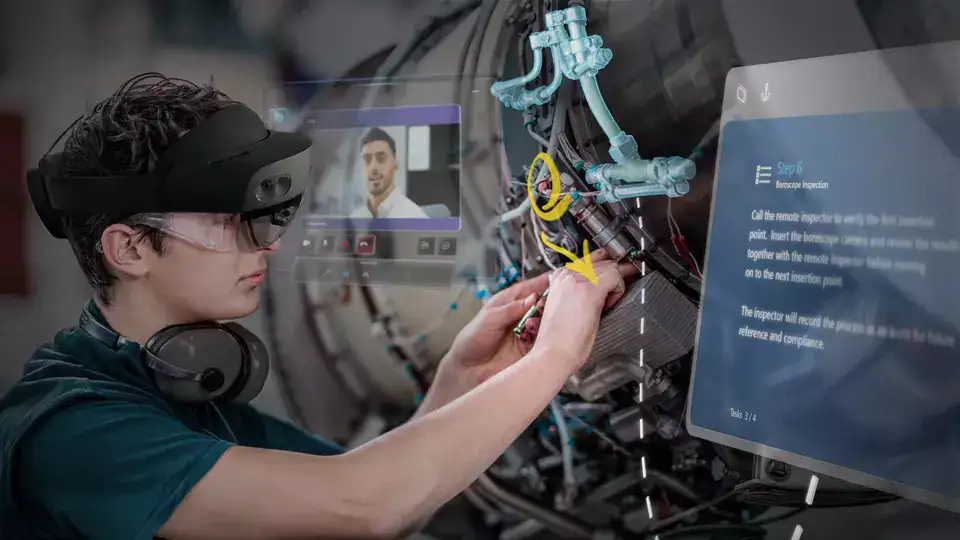
Key Applications of HoloLens 2
Use Cases in Business and Industry
Remote Assistance
One of the most powerful applications of HoloLens 2 in the business realm is remote assistance. Through Dynamics 365 Remote Assist, technicians on the field can collaborate with experts located anywhere in the world. The expert can see the technician’s view, guide them using annotations, and even share helpful documents or diagrams. This capability drastically reduces downtime, as complex issues can be resolved without the need for experts to travel to the location.
Training and Education
HoloLens 2 can be used to provide immersive, interactive training experiences across various industries. For instance, in manufacturing, new employees can be trained on complex machinery without the risk of damaging expensive equipment. Similarly, in the retail sector, employees can be trained on customer service scenarios to improve their interpersonal skills.
Design and Product Development
With HoloLens 2, product designers can visualize and manipulate 3D models of their designs in the context of the real environment. This capability aids in better design decisions, faster prototyping, and more effective client presentations.

Applications in Healthcare
Surgery
Surgeons can use HoloLens 2 to overlay patient-specific anatomical data or surgical plans onto the patient, improving surgical precision and outcomes. Real-time imaging results can also be viewed in the operating room without the need for the surgeon to look away from the surgical field.,
Medical Training
Medical students can learn complex anatomy in an immersive, interactive way, improving understanding and retention. They can visualize and interact with 3D models of organs, systems, or entire bodies, providing a more practical and engaging learning experience than traditional textbooks.
Patient Care
In patient care, HoloLens 2 can provide medical professionals with hands-free access to patient data, allowing them to focus more on the patient. It can also facilitate telemedicine consultations, where the doctor and patient are in different locations.
Potential in Education and Research
Interactive Learning
In schools and universities, HoloLens 2 can provide students with interactive, 3D learning experiences that can make complex subjects more understandable and engaging. For example, students learning about the solar system can interact with a 3D model of the solar system, visualizing the planets’ movements and orbits in a way that a 2D textbook can’t replicate.
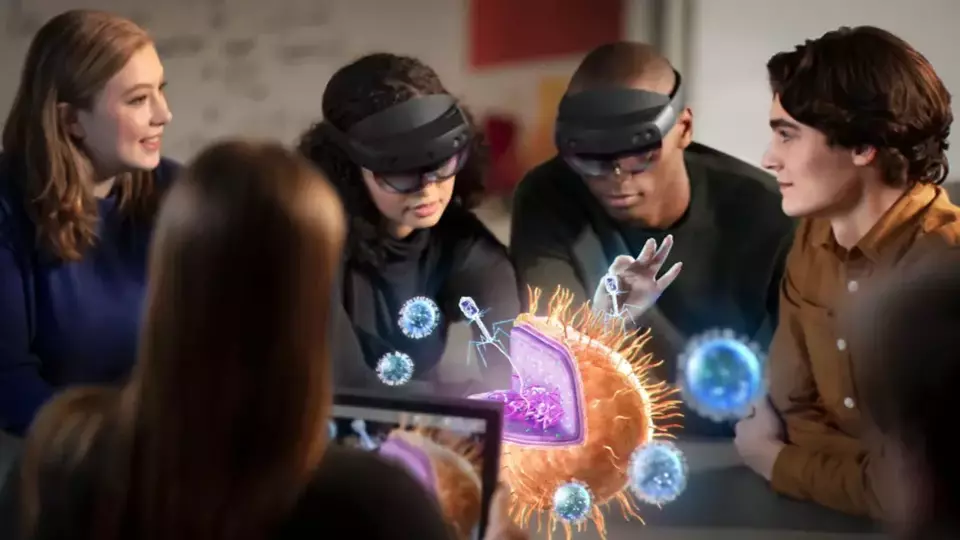
Research and Development
In research fields, HoloLens 2 can enable researchers to visualize and interact with data in new ways, potentially leading to new insights and discoveries. For instance, a researcher studying molecular structures can view and manipulate 3D models of molecules, gaining a deeper understanding of their structures and interactions.
Accessibility
HoloLens 2 can also be a powerful tool for accessibility in education. For example, visually impaired students can use audio-based mixed reality applications to interact with their learning environment, while students with mobility issues can explore virtual field trips or labs that may otherwise be physically challenging to navigate.
The above applications merely scratch the surface of HoloLens 2’s potential. As the device continues to evolve and more developers create applications for it, the possibilities for its use will continue to expand.
The Competition: HoloLens 2 vs. the World
The Battle of the Realities: HoloLens 2 vs. HoloLens 1
When compared to its predecessor, the HoloLens 2 offers significant improvements in several areas:
-
Field of View: The HoloLens 2 boasts a field of view that’s more than double that of the first-generation HoloLens. This expanded field of view allows for more immersive and comprehensive mixed reality experiences.
-
Comfort and Wearability: With a design focused on balance and comfort, HoloLens 2 offers a more comfortable user experience, even during extended periods of use. This is in stark contrast to the original HoloLens, which was often critiqued for its less comfortable fit.
-
Hardware specs: HoloLens 2 has a more powerful Holographic Processing Unit (HPU) with eight cores instead of four, a larger battery, and more powerful RAM (up to 8 GB compared to 2 GB in HoloLens 1)
-
Interaction: HoloLens 2 offers advanced hand and eye tracking capabilities, allowing for more intuitive interactions with holograms. While the original HoloLens allowed for gestures, the second generation’s hand tracking supports more complex and natural interactions.

Reality Showdown: HoloLens 2 against Other AR/VR/MR Devices
Comparing HoloLens 2 to other mixed reality devices on the market:
Magic Leap 1
While Magic Leap 1, another popular MR device, offers an immersive experience with a strong focus on consumer applications like gaming and entertainment, HoloLens 2 targets enterprise use with a robust application ecosystem, especially around Dynamics 365. Additionally, HoloLens 2 provides better comfort for extended usage, a more intuitive user interface, and more advanced hand and eye tracking capabilities.

Meta Oculus Quest 2
Oculus Quest 2 is primarily a VR device, meaning it doesn’t incorporate the user’s environment into the virtual experience as HoloLens 2 does. While the Quest 2 may offer more robust gaming experiences due to its focus on VR, HoloLens 2 provides a more versatile experience by merging the physical and digital worlds.

Google Glass Enterprise Edition 2
Google’s offering, like HoloLens 2, is targeted towards enterprise use. However, Google Glass focuses more on providing information in a hands-free manner rather than creating immersive mixed reality experiences. While Google Glass is lighter and cheaper, HoloLens 2 offers more advanced MR capabilities, a more robust field of view, and more substantial app support.

Each of these devices has strengths based on their intended use cases and target audiences. HoloLens 2 stands out for its advanced MR capabilities, focus on enterprise applications, and efforts to balance comfort and functionality.
VII. Potential Future Developments
Expected Future Upgrades
While specific details about future versions of the HoloLens are not public, certain trends and technological advances provide clues about possible upgrades:
Improved Field of View
Despite the significant improvement from the first to second generation, the field of view on HoloLens 2 is still a limiting factor for full immersion. Future upgrades may further increase the field of view.
Lighter and More Compact Design
Wearability is a crucial factor in the acceptance of AR/VR/MR devices. Future iterations of the HoloLens could aim for an even lighter, more comfortable design.
Battery Life
As with all portable devices, battery life is a key factor. As technology evolves, we can expect future versions of the HoloLens to offer longer battery life.
5G Connectivity
The incorporation of 5G connectivity could allow for faster and more efficient data transfer, improving the device’s performance when dealing with complex, data-heavy applications.
Advances in AI
Future upgrades may see further integration of AI, enhancing voice and gesture recognition, improving spatial understanding, and possibly even introducing features we can’t yet imagine.

Market Trends and Future Applications
As mixed reality technology advances, several market trends and future applications become possible:
Greater Consumer Adoption
While HoloLens 2 is primarily focused on the enterprise market, future developments could see broader consumer adoption. This would require a reduction in price, advances in wearable comfort, and the development of more consumer-friendly applications, such as games or home-based AR experiences.
Remote Work
The COVID-19 pandemic has highlighted the value of remote work tools, and mixed reality can be a significant player in this space. Future applications could include fully immersive remote meetings or the ability to create a customizable, virtual workspace.
Integration with IoT
As the Internet of Things (IoT) continues to grow, there will likely be more integration between MR devices like HoloLens and IoT devices. This could lead to smart home control applications, industrial IoT uses, and more.
Advanced Training Simulations
Mixed reality has already proven to be a valuable tool for training. As the technology improves, we can expect even more advanced and realistic training simulations that can be applied across a multitude of industries.
Accessibility
HoloLens and similar technologies could be used to create more accessible environments for people with disabilities, such as spatial audio experiences for visually impaired individuals or sign language recognition for those with hearing impairments.
As with all predictions about future technology, these are educated guesses based on current trends and may not fully encompass the unexpected advances or shifts that the future holds. The potential of HoloLens and mixed reality technology is vast and continues to unfold.
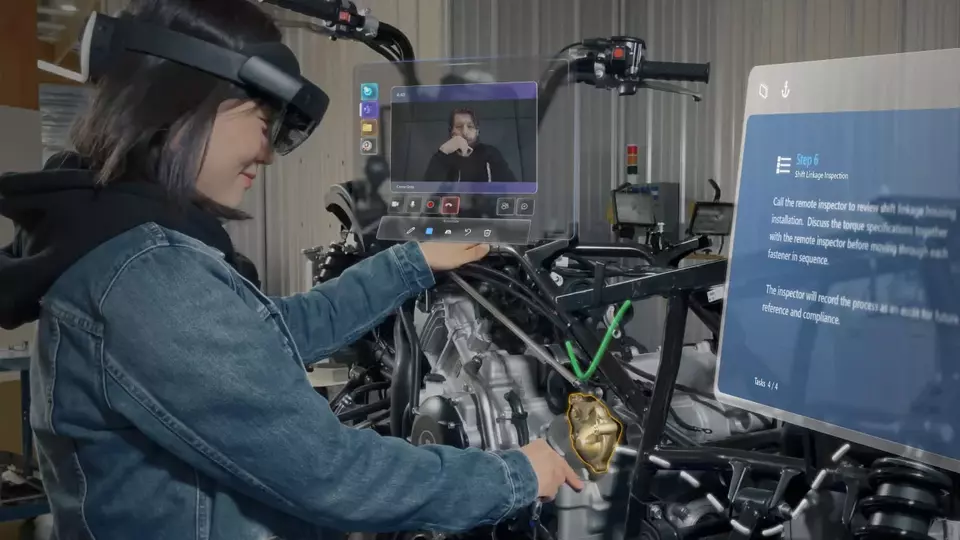
VIII. Conclusion
Recap of Key Points
Microsoft’s HoloLens 2 is a revolutionary mixed reality device that represents a significant advancement over its predecessor and other MR/AR/VR devices on the market. It boasts a more extensive field of view, better comfort and wearability, and improved interaction through advanced hand and eye-tracking capabilities.
The device’s core technologies—spatial mapping, gaze tracking, and gesture and voice recognition—are underpinned by the dedicated Holographic Processing Unit (HPU), allowing the HoloLens 2 to seamlessly integrate digital content into the user’s environment. This combination of hardware and software results in an impressive user experience, with intuitive setup and calibration, an easy-to-navigate user interface, and robust application support.
HoloLens 2’s potential applications are vast, spanning sectors such as business, healthcare, and education. Whether it’s facilitating remote collaboration and immersive training in business, augmenting surgical precision and patient care in healthcare, or promoting interactive learning in education, HoloLens 2 is poised to revolutionize how we work, learn, and communicate.
Personal Opinion and Final Thoughts
The HoloLens 2 is a fantastic example of how far technology has advanced in the field of mixed reality. Microsoft’s focus on enterprise applications is wise, given the practicality and immediate value it offers in this space—whether in design, training, remote assistance, or healthcare. However, its price point may still be a limiting factor for wider adoption, especially in the consumer market.
Looking towards the future, I anticipate that mixed reality devices will continue to become more immersive, more intuitive, and more comfortable. As they do, I expect that the line between our physical world and the digital world will continue to blur, leading to more innovative applications and more widespread adoption of this technology.
The evolution of mixed reality represents a promising frontier for both technology and society. As we continue to explore its potential, devices like the HoloLens 2 will undoubtedly play a crucial role in shaping our digital future.

